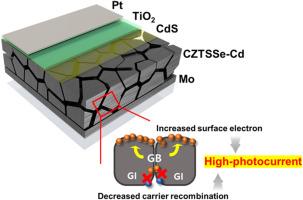在中性条件下,利用镉掺杂在CZTSSe中裁剪晶界缺陷以实现太阳能驱动的高效析氢
IF 9.7
2区 材料科学
Q1 MATERIALS SCIENCE, MULTIDISCIPLINARY
引用次数: 0
摘要
Cu2SnZn(S, Se)4 (CZTSSe)已成为光电化学(PEC)水分解装置以及传统的铜铟镓硒(CIGS)光伏电池的可持续的,地球丰富的替代品,用于太阳能燃料生产。然而,由于固有的材料挑战,包括二次相偏析、晶界缺陷和相关的载流子复合损失,CZTSSe的性能仍然受到限制。本文研究了利用化学浴沉积技术(CBD)制备Pt/TiO2/CdS/CZTSSe-Cd/Mo光电阴极。结合溅射和CBD工艺,获得了高质量的CZTSSe-Cd薄膜,有效抑制了Zn缺陷簇,减轻了晶界处与Zn相关的反位缺陷。结果表明,由CZTSSe-Cd组成的光伏器件的最大功率转换效率为9.26%。此外,作为太阳能驱动析氢的光电阴极,在中性电解质(pH 7)中,CZTSSe- cd提供了19.05 mA/cm2 (0 VRHE)的光电流密度,比原始CZTSSe (~ 13.47 mA/cm2)提高了41.4%。cd诱导的缺陷钝化减少了非辐射复合,改变了带对准,提高了电荷提取效率,进一步提高了器件效率。结果表明,阳离子掺杂是释放kesterite吸收剂在实际太阳能燃料应用中的全部潜力的关键途径。本文章由计算机程序翻译,如有差异,请以英文原文为准。


Tailoring grain boundary defects via Cd doping in CZTSSe for efficient solar-driven hydrogen evolution under neutral conditions
Cu2SnZn(S, Se)4 (CZTSSe) has emerged as a sustainable, earth-abundant alternative to photoelectrochemical (PEC) water splitting devices as well as conventional copper indium gallium selenide (CIGS) photovoltaics for solar fuel production. However, limitations in the performance of CZTSSe persist due to intrinsic material challenges involving secondary phase segregation, grain boundary defects, and associated carrier recombination losses. This work demonstrates the fabrication of Pt/TiO2/CdS/CZTSSe-Cd/Mo photocathode with strategic Cd doping via the chemical bath deposition (CBD). With combined sputter and CBD processes, the obtained high-quality CZTSSe-Cd films effectively suppress Zn defect clusters and alleviate Zn-related antisite defects at grain boundaries. As a result, the photovoltaic device comprised of CZTSSe-Cd achieved a maximum power conversion efficiency of 9.26 %. Moreover, as a photocathode for solar-driven hydrogen evolution, the CZTSSe-Cd delivered a record photocurrent density of 19.05 mA/cm2 (at 0 VRHE) in a neutral electrolyte (pH 7), representing a 41.4 % enhancement over pristine CZTSSe (∼13.47 mA/cm2). The Cd-induced defect passivation reduces the non-radiative recombination and modifies the band alignment enhancing charge extraction efficiency, further contributing to the overall boost in device efficiency. The results demonstrate that cation doping is a critical pathway for unlocking the full potential of kesterite absorbers in practical solar fuel applications.
求助全文
通过发布文献求助,成功后即可免费获取论文全文。
去求助
来源期刊

Materials Today Physics
Materials Science-General Materials Science
CiteScore
14.00
自引率
7.80%
发文量
284
审稿时长
15 days
期刊介绍:
Materials Today Physics is a multi-disciplinary journal focused on the physics of materials, encompassing both the physical properties and materials synthesis. Operating at the interface of physics and materials science, this journal covers one of the largest and most dynamic fields within physical science. The forefront research in materials physics is driving advancements in new materials, uncovering new physics, and fostering novel applications at an unprecedented pace.
 求助内容:
求助内容: 应助结果提醒方式:
应助结果提醒方式:


